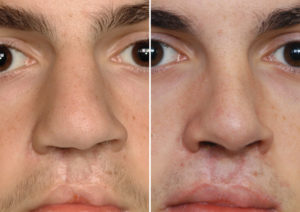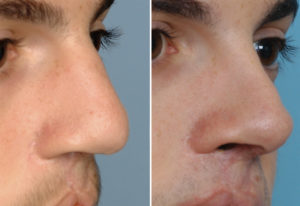Background: The bilateral cleft lip and palate deformity poses major reconstructive challenges. At its root cause is the shortage of tissue that has resulted from the cleft as well as scar tissue that has occurred from prior surgeries.
The bilateral cleft nose has many typical features from a wide and blunt nasal tip, an underdeveloped underlying septal support, a columellar shortage of skin and wide flaring nostrils.
A more complete rhinoplasty is done in the bilateral cleft patient during their teenage years when they are past puberty. There is some debate as to whether it should be done before or after an upper jaw advancement which is eventually needed in more than half of bilateral cleft patients. That would depend on when the jaw advancement is planned and how much forward movement is needed. But in most cases it is best done six months or longer after the LeFort I osteotomy has been done.
Case Study: This 17 year-old teenage male had multiple previous surgeries for a bilateral complete cleft lip and palate birth defect. He had completed his upper jaw surgery one year previously. He had a good occlusion and adequate upper lip support. His nose showed a strong and high dorsal line, wide nasal bones and a blunted and ill-defined nasal tip.


Highlights:
- The bilateral cleft nose poses a reconstructive challenge due to both tissue hypoplasia and tissue scar.
- The bilateral cleft rhinoplasty should be done after an upper jaw advancement =has been completed and healed to provide good skeletal support.
- The most important reconstructive element in the bilateral cleft nose is to achieve a strong columellar support onto which the nasal tip can be built.
Dr. Barry Eppley
Indianapolis, Indiana



